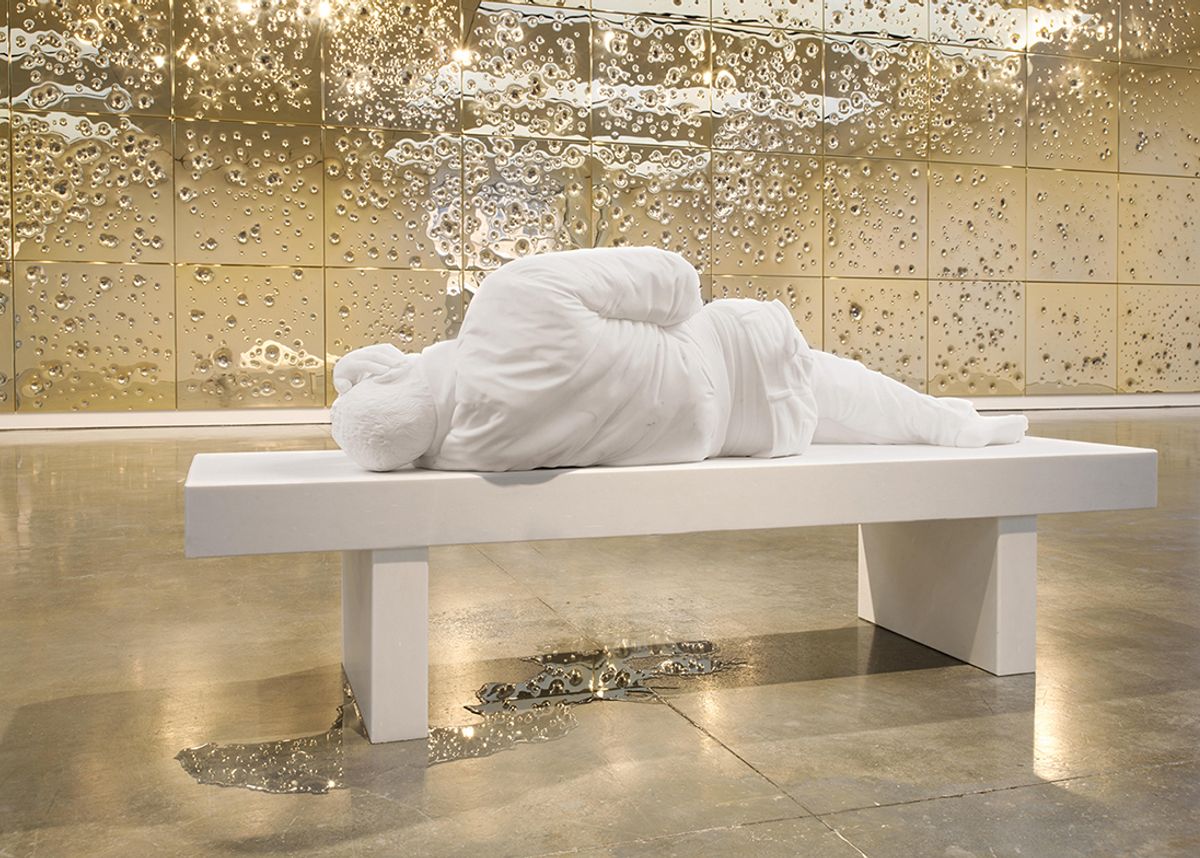In art we say that context is everything. That is especially true of high-concept art. It’s even more relevant to the work of Maurizio Cattelan. Sunday, the title piece in the Italian artist’s current exhibition at Gagosian’s arena-sized, West 21st Street gallery, features a gleaming wall of 24-carat gold-plated and polished stainless-steel panels riddled with the variously sized holes of bullets shot from five different kinds of weapons.
Outwardly the 64 panels reflect the daily incidence of gun violence in America as well as the enormous profits that gun manufacturers reap. More to the point is Sunday’s deliberate placement in a leading gallery that represents an accumulation of wealth and power. That environment, in a country distinguished by its citizens’ constitutionally protected right to arms, the luxe environment gives the piece sharp enough elbows to plough through a field crowded with gunshot art.
In 1964, Andy Warhol—now shown by Gagosian—watched in horror as a visitor to his studio put a bullet through a stack of freshly silkscreened Marilyns; two years ago, one sold at auction for a whopping $125m. This is the artist who, in 1968, suffered near-fatal gunshot wounds, only to turn it around in 1981 with Gun, a painting that depicts the type of revolver that almost killed him.
“In another space the idea would have been less direct,” Cattelan agreed, in a phone call from Costa Rica, where he was planning an upcoming show. “There was no strategy of moving out of Marian Goodman or killing anyone,” he added. “Sometimes an idea can be more valuable in a different context.” (Comedian, the banana that Cattelan duct-taped to the wall in a booth at Art Basel Miami Beach in 2019, is a case in point. Once removed from a fevered marketplace, it’s just another banana.)
Firearms, how do we love thee? Let us count the ways. In the early 1960s, Niki de Saint Phalle loaded plaster reliefs of the female form with paint sacs that exploded when she shot them with a 22-calibre rifle. This was not just a radical way to make a painting; symbolically, at least, it also wrangled male artist hegemony into submission. Cattelan chose one of her Tirs for The Third Hand, an exhibition at Stockholm’s Moderna Museet (until 12 January 2025), where he mixed a selection of his works with others in the museum’s collection.
His own canon also includes Shoot, the 1971 performance where Chris Burden had himself shot in the shoulder in a Los Angeles gallery. Three years later, a member of the audience attending Marina Abramoviç’s Rhythm O put a gun to the artist’s head, only to be tackled by others before he pulled the trigger.
Let’s not forget William Burroughs, who not only killed his wife but also paint-balled his canvases with a gun. Tom Sachs’S 1999 exhibition of functional, handmade guns included an Alvar Alto vase full of live bullets that he set on Mary Boone gallery's reception desk as if they were mints, resulting in the dealer’s arrest. What about Gregory Green’s suitcase bombs? “That was more about terrorism,” Cattelan noted.
Since the opening of his show in Chelsea, Cattelan has received notes from other artists who, he was surprised to learn, had used bullets and slabs of stainless steel as art materials. One, the British American artist Anthony James, had his lawyer send a protesting letter, though one can trace the idea to Margaret Evangeline, a Brooklyn-based painter who began shooting up mirror-polished stainless steel after 9/11, and to Abdel Abdessemed, who in 1997 lined a gallery in Lyon with galvanised steel sheets perforated by bullets. Since then, Matthew Day Jackson has exhibited reflective panels massacred by gunfire to resemble craters on the moon—and reflect our own responsibility for our weaponised society. “The more the merrier!” Cattelan joked.
He also invoked Philippe Starck’s gold Kalashnikov lamps and Throne of Weapons, a sculpture that Cristóvão Canhavato (aka Kester) made from assault rifles used in Mozambique’s civil war. Cattelan saw it at the British Museum, “in the gallery with the Rosetta Stone”, he says. “It’s disturbing.”
So, what it is it with artists and guns? "Violence is part of our lives,” Cattelan replies. “It cannot be separated from our lives.” This is the not the first time he has approached an artwork as if he were an executioner. Previously, he subjected a blackened American flag to a rain of bullets. If he is not the most subtle of artists, he’s not a simplistic moralist, either. The name of Cattelan's game is social satire but, like all humour (and critique), it’s an antidote to pain—and it’s personal.
November, the other element of his Gagosian show, is a marble “fountain” in the form of a park bench on which the figure of a semi-somnolent man is lying on its side, pants unzipped, urinating on the floor in front of the wounded golden wall. It’s not a middle finger to gun profiteers, nor to the collectors who have been buying individual panels for $300,000 a pop, but a memorial to Cattelan’s close friend and business partner, Lucio Zotti, who died last September.
For All, his 2011 retrospective at the Guggenheim Museum, Cattelan suspended his entire oeuvre from the ceiling as if they were marionettes—or carcasses. Yet, he says, “It was only last year that I realised everything except my very earliest work may be connected to loss or death. It’s incredible how often it repeats itself.”
• Maurizio Cattelan: Sunday, Gagosian West 21st Street, New York, until 15 June


